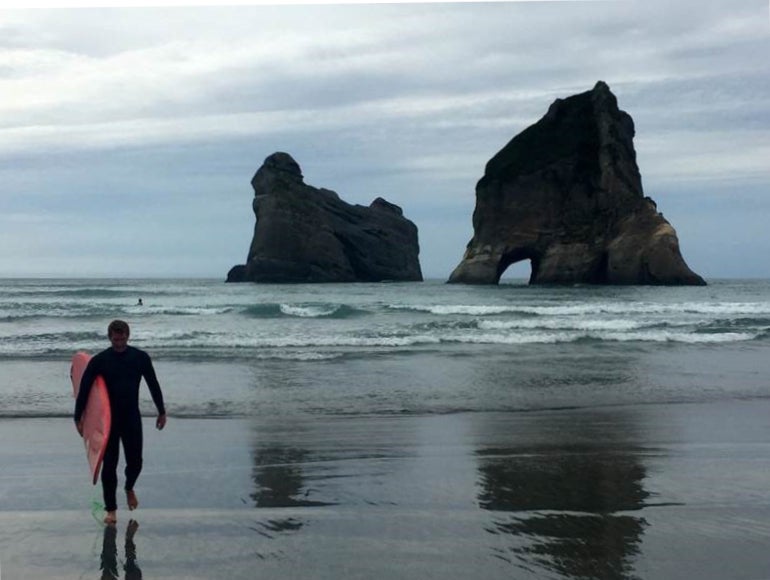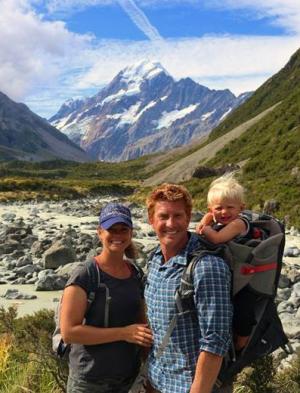Five questions for Matthew Hallowell
In 2008, after Matthew Hallowell received his Ph.D. in civil engineering from Oregon State University, he received multiple hiring offers. He ultimately chose a position with the University of Colorado Boulder‘s Department of Civil, Environmental and Architectural Engineering (CEAE) “because of the collegiality and reputation of the program, the quality of the students and the work-life balance that can be attained in Boulder.” And then there was the matter of the mountains. He’s a hiker and mountain biker. (When he gets close to an ocean, he’s also a surfer.)
CU has been a good fit for him, and the university has gained from his presence. Hallowell is the Beavers Endowed Associate Professor of Construction Engineering, teaching undergraduate and graduate classes. He has received multiple awards and accolades, including those for research and teaching, and also for his mentorship of students and junior faculty.
Earlier this year, he was named a President’s Teaching Scholar. His nominator said this: “Matthew Hallowell has been an outstanding teacher, researcher and role model for our students. Through his research, he has brought modern and innovative tools to the field of construction safety. … As a teacher in the classroom, he is creative and innovative. He is inspirational to his students. … Matt is also an enthusiastic adviser and mentor. … (His) mentorship extends beyond the University of Colorado and beyond his own students, through his work of mentoring junior Civil Engineering faculty from around the country …”
The Teaching Scholar honor and the College of Engineering and Applied Science Outstanding Adviser Award are especially significant to him, “Because they are based, in large part, on nominations and letters from existing and former students. It means a lot to me to know that my teaching is valued and that the students are getting a high-quality learning experience. I attribute much of my success to the support and mentoring from my colleagues in the Department of Civil, Environmental and Architectural Engineering – Gregor Henze and Keith Molenaar in particular.”
Along with his forays into the mountains, he enjoys traveling and spending as much time as possible with his wife, Robyn, and son Rowan. He’s also getting ready for an addition to the family: His second child is due to arrive in February.
1. How did you choose this career path?
My career path was the result of a series of serendipitous events. As a student, I did not have the long-term goal of becoming a professor.
It wasn’t until I met Professor Mike Toole at Bucknell University, who would later become my master’s thesis adviser, that I began to see academia as a possibility for me. Mike’s rapport with his students, his intelligence and his passion for teaching and research inspired me. Mike also gave me my first chance to do research. For the first time, I thought: “I might be able to do this … I might love this.”
When pursuing my Ph.D., my adviser at Oregon State, John Gambatese, fostered my growth as an academic. John was another model academic who was brilliant, personable and wildly creative. I began to develop my toolkit as a researcher, had my first teaching experience and was given the opportunity to be creative and take risks. By the end of my Ph.D. studies, I knew academia was for me.
2. Much of your research is focused on construction safety. How did you decide on this research topic and what have your studies found?
I became interested in construction safety once I learned that the field was much, much more than simple Occupational Safety and Health Administration compliance. The field involves elements of sociology, psychology, engineering, risk analysis, law, leadership, culture, etc. When I learned that I could apply, integrate and advance science in each of these domains while simultaneously helping to decrease injuries and illnesses in the working population, I was sold. After all, nearly 1,000 Americans lose their lives on construction sites every year – the most of any single-service industry. If we advance science that helps to improve these rates by only 1 percent, we can make important progress.
The research in our lab has recently focused on hazard recognition. In the last few years we discovered that people are only able to recognize and address half of the hazards that they will face on the job in a given work period. This is true even for very high-risk work. The safety profession has long assumed that people can see danger and simply need a forum in which to discuss, document and mitigate hazards. However, the act of recognizing hazards is far more complex than originally thought.
We have found that some hazards, like fall hazards, are comparatively easy for people to identify and mitigate. These types of hazards are recognized by the part of the brain that processes emotion like fear and activate the “fight or flight” response when encountered. I think of the example of being at the top of a 20-story building with no fall protection. The average person needs no training to see the hazard, and, in fact, develops a physiological response to an exposure to the fall hazard. Other hazards, like pressure and chemicals, are comparatively more difficult for people to recognize, are processed by accessing long-term memory and do not generate a physiological or emotional response.
I find this research area fascinating because a greater understanding of the science of hazard recognition allows us to better design training programs, resources and safety activities that enable safer work environments.
3. One program you developed that enables safer work environments is called precursor analysis. What is precursor analysis and how does it help reduce project hazards?
Precursor analysis is a very new procedure that involves identifying the presence of known precursors of serious incidents and fatalities through a brief, but targeted, discussion with a work crew. Through a series of experiments and field observations, we found 16 very strong predictors that range from unusual levels of schedule pressure to a poor plan for change. When precursor analysis is used effectively, a manager can briefly engage with a crew, identify the presence or absence of specific warning signs of an event through the structured discussion and take action before an event occurs.
I am very passionate about this area because it is both scientifically supported in journal publications and is being adopted at a very high rate by the industry.
4. You recently were honored as a President’s Teaching Scholar and have earned accolades for your work with students, both in the classroom and as a mentor. What is your teaching mission and why are you passionate about passing on your knowledge?
My mission as a teacher is to inspire students to learn, provide meaningful context, communicate objectives early, facilitate the acquisition of knowledge through clear explanation and multiple modes of delivery, provide opportunities to practice with feedback and motivate students to continue learning. Because I teach both engineering and management concepts, I use a wide variety of teaching modes. For engineering principles, I tend to use physical modules that help to make complex topics more accessible. For management topics, I tend to use simulation activities of real-world cases. I think it is very important to remember that there are many different ways that students learn and that it is my responsibility to incorporate different methods of teaching to address these different learning styles.
5. Do you have a favorite item or artifact that you keep in your office, and if so, what is it and what is the story behind it?
My office is full of small trinkets from throughout the world. One of the great things about being a professor is that I get to work with students from so many different cultures. Often, students will bring me a trinket from their home and I add them to my collection. I have lots of very interesting items that range from fabric to a fishing lure. They make for great conversation pieces and serve as excellent mementos from years past.



